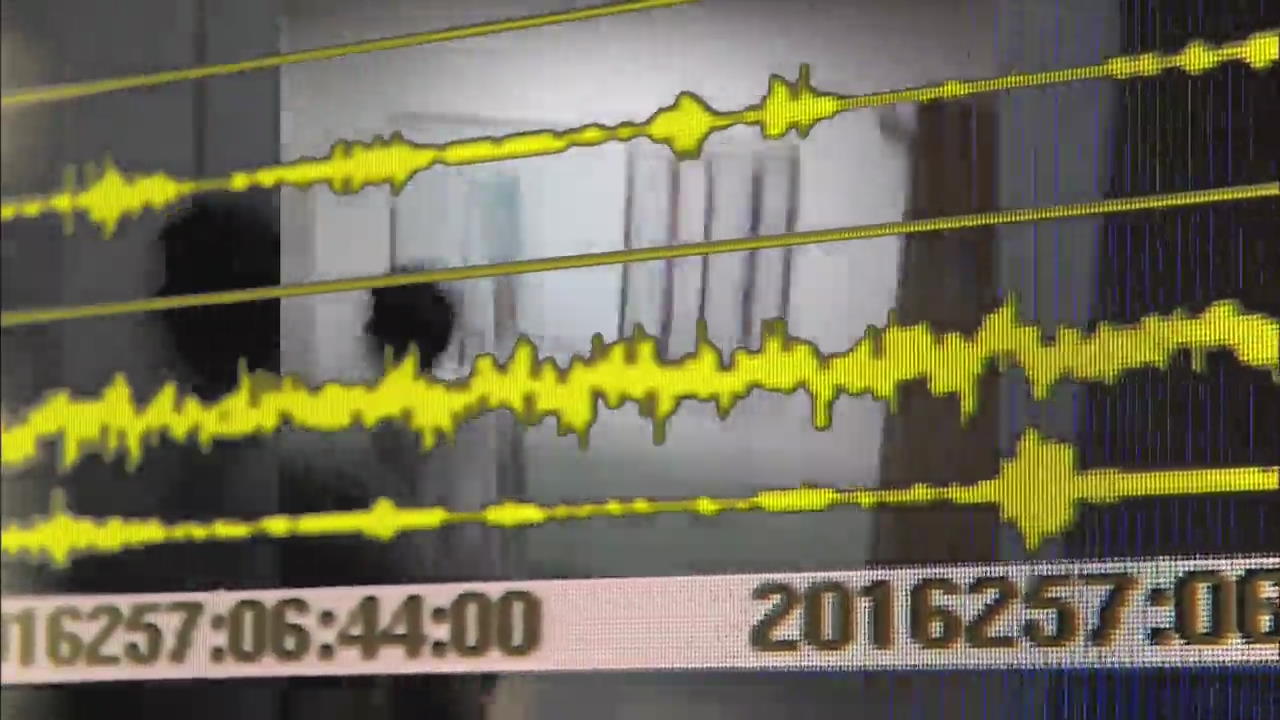Yangsan Fault Line
입력 2017.11.16 (15:00)
수정 2017.11.16 (16:43)
읽어주기 기능은 크롬기반의
브라우저에서만 사용하실 수 있습니다.
[Anchor Lead]
The quake in Pohang is believed to have been caused by seismic activity on a branch of the Yangsan Fault, as was the case with the Gyeongju earthquake last year. Concerns that more tremors could occur along this fault line unfortunately appear to be well founded.
[Pkg]
The earthquake in Gyeongju last year was caused by an unknown fault that branched out of the Yangsan Fault. Following the powerful quake resulting from a fault line whose existence was not even known, experts have warned that there is no knowing when other nameless faults could also become active.
[Soundbite] Seon Chang-guk(Korea Institute of Geoscience & Mineral Resources) : "If we assume seismic powers are accumulated somewhere along the major Yangsan fault belt, this raises the probability of quakes occurring from these affected fault lines. For now, we do not know where the fault lines are located but we must find them fast."
Over 600 aftershocks occurred since the Gyeongju quake, leading to speculation that another powerful tremor could break out near the Yangsan Fault. The Pohang earthquake is also believed to have been caused by a branch of the same fault line. The worries have turned out to be true.
[Soundbite] Lee Mi-seon(KMA) : "The epicenter is believed to be near the Jangsa Fault which is related to the Yangsan Fault. But more analysis is under way."
The issue now is to what degree the Yangsan Fault has been activate since last year. The great earthquake in eastern Japan in 2011 destabalized tectonic plates on the Korean Peninsula. On top of this, depending on the activitation level of underground faults, even bigger earthquakes could be in store in the future.
[Soundbite] Prof. Hong Tae-kyung(Yonsei University) : "Magnitude 7 quakes are believed to be the maximum level possible on the Korean Peninsula. The latest tremor may give rise to bigger quakes in the future."
Experts say that if the triangular region connecting Pohang and Ulsan is rocked, this could possibly move the Ulsan Fault line. There are calls for close and thorough observation of aftershocks reported from now on.
The quake in Pohang is believed to have been caused by seismic activity on a branch of the Yangsan Fault, as was the case with the Gyeongju earthquake last year. Concerns that more tremors could occur along this fault line unfortunately appear to be well founded.
[Pkg]
The earthquake in Gyeongju last year was caused by an unknown fault that branched out of the Yangsan Fault. Following the powerful quake resulting from a fault line whose existence was not even known, experts have warned that there is no knowing when other nameless faults could also become active.
[Soundbite] Seon Chang-guk(Korea Institute of Geoscience & Mineral Resources) : "If we assume seismic powers are accumulated somewhere along the major Yangsan fault belt, this raises the probability of quakes occurring from these affected fault lines. For now, we do not know where the fault lines are located but we must find them fast."
Over 600 aftershocks occurred since the Gyeongju quake, leading to speculation that another powerful tremor could break out near the Yangsan Fault. The Pohang earthquake is also believed to have been caused by a branch of the same fault line. The worries have turned out to be true.
[Soundbite] Lee Mi-seon(KMA) : "The epicenter is believed to be near the Jangsa Fault which is related to the Yangsan Fault. But more analysis is under way."
The issue now is to what degree the Yangsan Fault has been activate since last year. The great earthquake in eastern Japan in 2011 destabalized tectonic plates on the Korean Peninsula. On top of this, depending on the activitation level of underground faults, even bigger earthquakes could be in store in the future.
[Soundbite] Prof. Hong Tae-kyung(Yonsei University) : "Magnitude 7 quakes are believed to be the maximum level possible on the Korean Peninsula. The latest tremor may give rise to bigger quakes in the future."
Experts say that if the triangular region connecting Pohang and Ulsan is rocked, this could possibly move the Ulsan Fault line. There are calls for close and thorough observation of aftershocks reported from now on.
■ 제보하기
▷ 카카오톡 : 'KBS제보' 검색, 채널 추가
▷ 전화 : 02-781-1234, 4444
▷ 이메일 : kbs1234@kbs.co.kr
▷ 유튜브, 네이버, 카카오에서도 KBS뉴스를 구독해주세요!
- Yangsan Fault Line
-
- 입력 2017-11-16 15:17:31
- 수정2017-11-16 16:43:00

[Anchor Lead]
The quake in Pohang is believed to have been caused by seismic activity on a branch of the Yangsan Fault, as was the case with the Gyeongju earthquake last year. Concerns that more tremors could occur along this fault line unfortunately appear to be well founded.
[Pkg]
The earthquake in Gyeongju last year was caused by an unknown fault that branched out of the Yangsan Fault. Following the powerful quake resulting from a fault line whose existence was not even known, experts have warned that there is no knowing when other nameless faults could also become active.
[Soundbite] Seon Chang-guk(Korea Institute of Geoscience & Mineral Resources) : "If we assume seismic powers are accumulated somewhere along the major Yangsan fault belt, this raises the probability of quakes occurring from these affected fault lines. For now, we do not know where the fault lines are located but we must find them fast."
Over 600 aftershocks occurred since the Gyeongju quake, leading to speculation that another powerful tremor could break out near the Yangsan Fault. The Pohang earthquake is also believed to have been caused by a branch of the same fault line. The worries have turned out to be true.
[Soundbite] Lee Mi-seon(KMA) : "The epicenter is believed to be near the Jangsa Fault which is related to the Yangsan Fault. But more analysis is under way."
The issue now is to what degree the Yangsan Fault has been activate since last year. The great earthquake in eastern Japan in 2011 destabalized tectonic plates on the Korean Peninsula. On top of this, depending on the activitation level of underground faults, even bigger earthquakes could be in store in the future.
[Soundbite] Prof. Hong Tae-kyung(Yonsei University) : "Magnitude 7 quakes are believed to be the maximum level possible on the Korean Peninsula. The latest tremor may give rise to bigger quakes in the future."
Experts say that if the triangular region connecting Pohang and Ulsan is rocked, this could possibly move the Ulsan Fault line. There are calls for close and thorough observation of aftershocks reported from now on.
The quake in Pohang is believed to have been caused by seismic activity on a branch of the Yangsan Fault, as was the case with the Gyeongju earthquake last year. Concerns that more tremors could occur along this fault line unfortunately appear to be well founded.
[Pkg]
The earthquake in Gyeongju last year was caused by an unknown fault that branched out of the Yangsan Fault. Following the powerful quake resulting from a fault line whose existence was not even known, experts have warned that there is no knowing when other nameless faults could also become active.
[Soundbite] Seon Chang-guk(Korea Institute of Geoscience & Mineral Resources) : "If we assume seismic powers are accumulated somewhere along the major Yangsan fault belt, this raises the probability of quakes occurring from these affected fault lines. For now, we do not know where the fault lines are located but we must find them fast."
Over 600 aftershocks occurred since the Gyeongju quake, leading to speculation that another powerful tremor could break out near the Yangsan Fault. The Pohang earthquake is also believed to have been caused by a branch of the same fault line. The worries have turned out to be true.
[Soundbite] Lee Mi-seon(KMA) : "The epicenter is believed to be near the Jangsa Fault which is related to the Yangsan Fault. But more analysis is under way."
The issue now is to what degree the Yangsan Fault has been activate since last year. The great earthquake in eastern Japan in 2011 destabalized tectonic plates on the Korean Peninsula. On top of this, depending on the activitation level of underground faults, even bigger earthquakes could be in store in the future.
[Soundbite] Prof. Hong Tae-kyung(Yonsei University) : "Magnitude 7 quakes are believed to be the maximum level possible on the Korean Peninsula. The latest tremor may give rise to bigger quakes in the future."
Experts say that if the triangular region connecting Pohang and Ulsan is rocked, this could possibly move the Ulsan Fault line. There are calls for close and thorough observation of aftershocks reported from now on.
이 기사가 좋으셨다면
-
좋아요
0
-
응원해요
0
-
후속 원해요
0

















이 기사에 대한 의견을 남겨주세요.